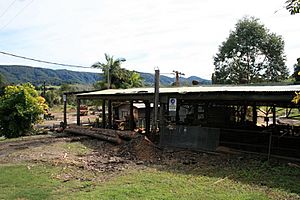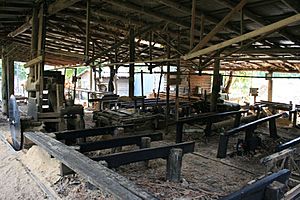Kin Kin Sawmill facts for kids
Quick facts for kids Kin Kin Sawmill |
|
|---|---|

Kin Kin Sawmill, 2009
|
|
| Location | 1 Sister Tree Creek Road, Kin Kin, Shire of Noosa, Queensland, Australia |
| Design period | 1940s - 1960s (post-World War II) |
| Built | 1940s |
| Owner | Geoff Ellis |
| Official name: Kin Kin Sawmill | |
| Type | state heritage (built) |
| Designated | 27 November 2008 |
| Reference no. | 602686 |
| Significant period | 1940s-1950s |
| Significant components | machinery/plant/equipment - forestry/timber industry, shed - machinery, lumber yard |
| Lua error in Module:Location_map at line 420: attempt to index field 'wikibase' (a nil value). | |
The Kin Kin Sawmill is a special old sawmill found at 1 Sister Tree Creek Road in Kin Kin, Queensland, Australia. It was built in the 1940s. This sawmill is so important that it was added to the Queensland Heritage Register on 27 November 2008. This means it is protected because it shows us a lot about Queensland's past.
Contents
The Story of Kin Kin Sawmill
The Kin Kin Sawmill was started in 1948. It was built by Arthur Hempsall and his son Lionel. The sawmill is located between Gympie and Noosa. This area is now known as the Sunshine Coast.
The Hempsall family owned the mill until 1991. Then, Geoff Ellis bought it. Today, the sawmill still works. It uses many of its original machines and has kept its old layout.
In the middle of the 1900s, South Queensland made the most timber in the state. The Sunshine Coast region had many sawmills. In 1949, there were about 122 sawmills there. This was the highest number in all of Queensland.
Why Was the Sawmill Built?
The Kin Kin sawmill was first built to make wooden boxes. These boxes were used for packing fruit. The local area grew a lot of fruit. Kin Kin was famous for growing bananas in the early 1900s.
The sawmill made boxes for bananas, pineapples, beans, apples, and plums. These fruit boxes were sent by train from Pomona railway station. They went to places like Brisbane and the fruit farms near Stanthorpe.
Making wooden boxes was a big business. It helped use up timber that might not have been used otherwise. After World War II, there was a high demand for fruit and vegetable boxes. The making of these boxes was busiest in 1949.
About 45% of the boxes were for fresh fruit. But they were also used for other foods and goods. By the early 1950s, new types of containers appeared. These were made from corrugated fibre board. They started to replace the old wooden boxes. So, the use of wooden boxes slowly went down.
In 1955-56, there were still about 58 companies in Queensland making wooden boxes. Most of these were small businesses. About 40% of these companies also cut timber for other uses.
How a Sawmill Works
Case mills were usually smaller than other sawmills. This was because they used smaller logs. They also made smaller final products. A small mill with three people could make up to 500 boxes a day.
First, logs were cut into long pieces called "flitches" at the main saw bench. Then, these flitches were cut to the right length at a docking saw. Waste wood was cut for firewood or thrown away. The pieces of timber ready for assembly were called "shooks".
Larger sawmills often had three circular saws and a docker. The first cut of a log was usually done at the "Canadian bench". This was the biggest circular saw. More cuts were made at other saws. Then, the planks were cut to length at the docker.
When the Kin Kin mill first opened, it had only one main saw bench and a docking saw. These saws are still there today. The docking saw has been moved inside the shed. A tractor powered the saws back then.
In the early 1950s, the mill got electricity. After that, a Canadian Saw and another saw bench were added. The docking saw was moved again. The way the mill is set up has not changed much since then. It looks like a typical sawmill from the 1950s.
The mill still has its original hand-operated winch. This winch was used to move logs through the main saw. You can also see the old electrical insulators. They show where the power cables ran under the roof.
What Timber Did It Cut?
The mill first cut soft wood for fruit boxes. This wood was cut to size and packed. Farmers would then put the boxes together. Later, the mill started cutting timber for pallets. It also cut hard wood for electricity poles and railway sleepers.
In 2007, the mill was cutting soft wood for glass packing cases. The Kin Kin Sawmill is one of the few sawmills from its time that is still working on the Sunshine Coast.
What Does the Sawmill Look Like?
The Kin Kin Sawmill is located on Sister Tree Creek Road. It sits on a flat, open area next to Kin Kin Creek. The sawmill has a large open shed. There is also a small timber office building. You can see other timber and corrugated iron sheds. There is also an area for sawdust and waste. The site also has places to store timber and park forklifts.
Inside the Main Sawmill Shed
The main part of the sawmill is a large, open shed. It has a timber frame and corrugated iron roofs. The roof is supported by round posts. The mill's operations are set up around its saws. These include benches, motors, trolleys, and rails.
The saws are in a line. They go from the main breakdown saw (Canadian saw) to the north. Timber logs are stacked by a forklift. They are then rolled onto a trolley. The logs are held tight and moved through the breakdown saw. This makes the first half cut.
The cut logs then roll to the next saw, called the number one bench saw. Here, the bark is taken off. The half logs are cut into planks that are about 2-or-2.5-inch (51 or 64 mm) wide. These planks are stacked. Then, they are taken to the number two bench saw. Here, they are cut into thinner boards, about 1 inch (25 mm) thick.
These thinner boards are stacked. They are then taken to the docker. The docker cuts them into shorter lengths, mostly 6 metres (20 ft) long. From there, the boards go to a groover. This machine makes grooves on the sides. Finally, they are put into a pallet stack.
There are also trolleys on rails. These trolleys take the leftover wood and waste from the saws. They carry it out to the west side of the shed.
You can still see the original hand-operated winch. It is used to move logs through the main saw. Also, old electrical insulators show where the power cables ran under the roof.
Why is Kin Kin Sawmill Important?
The Kin Kin Sawmill was added to the Queensland Heritage Register on 27 November 2008. It met certain rules to be listed.
Showing Queensland's History
The Kin Kin Sawmill (built in 1948) is important because it shows how Queensland's timber industry grew. When the mill was built, the Sunshine Coast was a very important timber-producing area. At that time, the Sunshine Coast had more sawmills than any other part of Queensland.
The sawmill also shows how the state's fruit-growing industry developed. It was first built to make timber for fruit packing cases. The Sunshine Coast was one of the best fruit-growing areas in Queensland back then. It also shows how timber was once used for packing cases. By the 1950s, new materials like corrugated fibre board started to replace wooden cases.
A Rare and Special Place
This sawmill is special in the region. It is a good example of a small sawmill that made timber for fruit packing cases. Mills like this were common in fruit-growing areas until the late 1950s. That's when wooden packing cases were used less often.
The mill is also rare because it has been working since the 1940s. The basic layout of the shed has not changed much since the 1950s. Many of the original machines are still used today. Because of money and environmental reasons, old sawmills like this are becoming very rare.
Showing Key Features of Sawmills
The Kin Kin Sawmill is a very complete example of a small sawmill. It was originally built to make timber for packing cases. It still has all the main parts you would find in a small mill from the 1950s. These include:
- The open-sided shed
- Old electrical insulators showing where the cables ran
- The main breakdown (Canadian) saw
- The number one and two saw benches
- The docking saw
- The original hand-operated winch
- Rails and trolleys
The way the mill works still follows the old method for making packing cases. Logs are first cut at the breakdown (Canadian) saw. Then, they are sized at the number one and two benches. Finally, they are cut to length at the docker.


